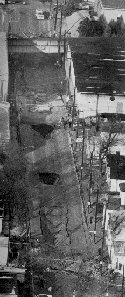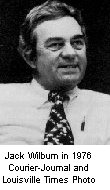
Courier-Journal and Louisville Times Photo by Larry Spitzer

Courier-Journal and Louisville Times Photo by Melissa Farlow
On May 1, 1983, heavy rain fell in Louisville, as it often does in the spring and summer. This time, it precipitated a crisis.
Most of southern Louisville is drained by the huge Southwestern Outfall, built by the old Commissioners of Sewerage. A combined sewer, it originally emptied directly into the Ohio River.
In 1960, a pump station was completed at Bells Lane to pump the wastewater from the outfall to the then-new treatment plant. It included massive metal gates to help control the water. Most of the time, the gates were kept closed, to keep wastewater from discharging into the river and to keep high water from the river from flowing back into the sewer system. But during heavy local rains, the gates were designed to be open, to allow water from the overloaded combined sewer system to overflow by gravity into the river.
During the intense thunderstorm of May 1, 1983, the gates failed to open. A large neighborhood in southwestern Louisville was flooded, to depths of as much as ten feet. About 400 families were driven from their homes. Police divers had to be called to help open the gates manually.
MSD blamed a power failure and equipment malfunctions for the problem. (The gates were electrically operated.)
Two days later the MSD board appropriated $3 million to help the flood victims, appointed a team to investigate the incident, and delayed action on a proposed rate increase. City government appointed its own team to investigate. Elected officials and newspaper editorials were highly critical of MSD’s management.
Ten days after the flood, Jack Wilburn announced he was stepping aside as MSD’s executive director, saying he hoped his resignation would help the agency solve its problems and regain public confidence. He recommended a nationwide search to find his replacement.
Jack Wilburn: Director In The Time Of Crises
John J. "Jack" Wilburn, MSD’s third top executive, was groomed for the job by Morris Forman.

"I got out of Speed (Scientific School at the University of Louisville) on a Friday and I came in here on Monday," he told Courier-Journal reporter Keith Runyon in 1972. "Mr. Forman hired me right away" as an engineer.
Wilburn had entered Speed School after returning from service in World War II. A 1939 graduate of Male High School, he had received special technical training in the Army.
His first task with MSD was inspecting construction projects. Next, he did design engineering. After that, he did a variety of engineering jobs. When Forman took the director’s position in 1965, he named Wilburn to succeed him as chief engineer — the director’s top assistant for engineering matters.
A friendly man with a ready smile, Wilburn was remembered for his willingness to delegate responsibility — and for his dedication through a period of repeated crises.
In May, 1983, Wilburn resigned as MSD’s executive director. The agency had come under heavy criticism because of the flooding caused by a failure at the southwestern pumping station at Bells Lane. "I felt if I removed myself, it would be for the best of MSD," he told the press. He suggested a nationwide search for his successor.
He also said MSD was "a well-organized, well-structured organization which has many loyal, dedicated, professional people, all of whom do an outstanding job."
He continued to work for the agency as a consultant until February, 1984, when he retired, saying he didn’t want to put pressure on the new executive director soon to be named.
MSD History continued - The Turnaround


